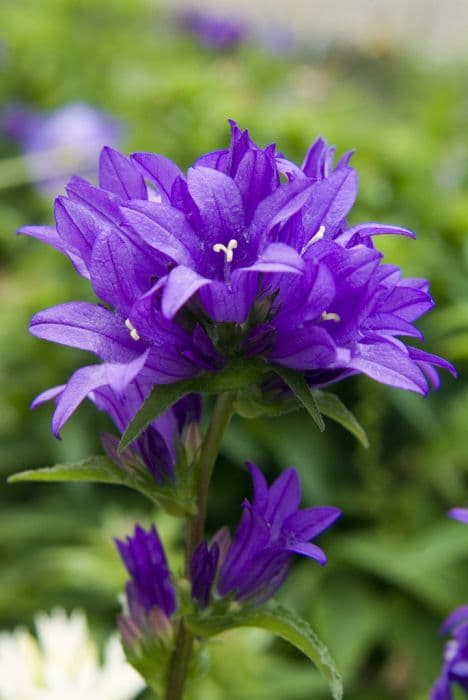Bellflower Campanula 'Misty Dawn'

ABOUT
Campanula 'Misty Dawn', commonly known as bellflower, boasts a charming and picturesque appearance, much admired by gardeners and flower enthusiasts. This particular variety is celebrated for its delightful floral display. The bellflower presents with a lush foliage base, typically exhibiting a green hue that can range from bright to dark shades, forming an attractive backdrop for its blooms. The flowers themselves are the key highlight, emerging in graceful bell-shaped formations that are evocative of the plant's common name. These blooms tend to be colored in a beautiful array of soft pastel tones, often showcasing a gentle gradient of color that may start from a white or cream base and blending into subtle shades of blue, lavender, or pink, depending on lighting and other environmental factors. Bellflower's blossoms are arranged on stems that rise from the central foliage clump, with each individual flower suspended daintily at the stem's tip. The petals of the blossoms display a pleasant, almost translucent quality that adds to their ethereal charm. Additionally, the center of the flowers is accented by small reproductive parts, which occasionally attract pollinators to the plant. Moreover, the foliage of the bellflower can also be a point of interest, with leaves presenting an oval to lance-shaped form, margins that may be smooth or slightly serrated, and a texture that's typically soft to the touch. The overall growth habit of the plant creates a pleasing and mounded shape, with the flowers prominently displayed above the leafy greens—giving it a layered and textured look that enhances its ornamental value in a garden setting. In summary, Campanula 'Misty Dawn' is a plant of noteworthy beauty, featuring lush foliage and captivating bell-shaped flowers that enchant onlookers with their gentle colors and elegant presentation, minus the details of the plant's size.
About this plant
 Names
NamesFamily
Campanulaceae
Synonyms
Bellflower, Misty Dawn Bellflower
Common names
Campanula 'Misty Dawn'
 Toxicity
ToxicityTo humans
Bellflower 'Misty Dawn' is generally not considered toxic to humans. There are no well-known toxic effects from ingesting this plant. However, as with any plant, individual allergies or sensitivities could potentially cause mild irritation or discomfort if parts of the plant are ingested or come into contact with the skin or mucous membranes.
To pets
Bellflower 'Misty Dawn' is also generally not considered toxic to pets. It is not known to cause serious illness or symptoms of poisoning in animals such as cats and dogs if they ingest parts of the plant. However, individual animals may have different sensitivities, and ingestion could potentially cause mild gastrointestinal upset. It's always a good practice to keep an eye on your pet and consult with a veterinarian if you notice any abnormal behavior or signs of distress after ingestion.
 Characteristics
CharacteristicsLife cycle
Perennials
Foliage type
Deciduous
Color of leaves
Green
Flower color
Blue
Height
1-2 feet (30-60 cm)
Spread
1-1.5 feet (30-45 cm)
Plant type
Herb
Hardiness zones
5
Native area
Europe
Benefits
 General Benefits
General Benefits- Attracts Beneficial Insects: Campanula, also known as bellflower, is known for attracting bees and butterflies, which are essential for pollination in the garden.
- Visual Appeal: The bellflower 'Misty Dawn' has visually striking flowers that enhance the aesthetic of gardens and landscapes with its soft lavender-blue blossoms.
- Low Maintenance: As a perennial, it requires relatively low maintenance once established, only needing occasional watering and deadheading to promote further blooming.
- Drought Tolerance: Once established, bellflowers are relatively drought-tolerant, making them suitable for gardens in areas with water restrictions.
- Cold Hardy: Bellflowers are known for their hardiness in cold temperatures, making them a reliable choice in temperate climates and extending their growing season.
- Ground Cover: The spreading habit of 'Misty Dawn' bellflower makes it an excellent choice for ground cover, suppressing weeds, and minimizing soil erosion.
- Wildlife Habitat: Provides shelter and food to wildlife, creating a more dynamic and supportive ecosystem within the garden.
- Versatile Use: Suitable for a variety of garden setups, including borders, rock gardens, and containers, adding flexibility to garden design.
- Cut Flowers: Its long stems and attractive blooms make bellflower 'Misty Dawn' a good choice for cut flower arrangements.
- Seasonal Interest: Offers extended bloom time from late spring through late summer, providing long-lasting visual interest in the garden.
 Medical Properties
Medical PropertiesThis plant is not used for medical purposes.
 Air-purifying Qualities
Air-purifying QualitiesThis plant is not specifically known for air purifying qualities.
 Other Uses
Other Uses- Flower Arrangements: The delicate blue flowers of Misty Dawn campanula can provide a soft color and dainty shape to floral arrangements, perfect for weddings or table centerpieces.
- Craft Projects: Dried campanula flowers can be used in scrapbooking, pressed flower art or to create natural decorations and ornaments.
- Photography Prop: Misty Dawn campanula's unique morning hue can serve as a beautiful subject or backdrop for photographers, particularly in macro photography.
- Culinary Garnish: Edible varieties of campanula flowers can be used to add a splash of color to salads, desserts, or as an elegant garnish for different dishes.
- Edible Oil: Some campanula species can be used to produce botanical oils that are used for flavoring in gourmet cooking.
- Fairy Gardens: Due to their small size and whimsical appearance, these flowers are often used to decorate miniature fairy gardens which are popular in craft and garden design.
- Educational Resource: Campanula can be used in schools or educational programs to teach children about plant growth, pollination, and horticulture.
- Textile Dyeing: The pigments from Misty Dawn campanula flowers may be used in natural dye processes for textiles, imparting soft shades of blue or purple.
- Art Supplies: The flowers or the pigment extract can be used to make natural inks for painting or as a natural colorant for crafting materials like playdough or slime.
- Companion Planting: Campanula can be planted among vegetables and other garden plants as it can attract pollinators which are beneficial for the surrounding flora.
Interesting Facts
 Feng Shui
Feng ShuiThe plant Bellflower is not used in Feng Shui practice.
 Zodiac Sign Compitability
Zodiac Sign CompitabilityThe plant Bellflower is not used in astrology practice.
 Plant Symbolism
Plant Symbolism- Gratitude - The bell-shaped flowers of Campanula, commonly known as bellflower, often symbolize gratitude, reflecting the notion of reverent or humble thankfulness.
- Constancy and Perseverance - Bellflowers are known for their ability to grow in challenging conditions, which lends to their symbolism for constancy and the ability to endure difficulties with grace.
- Unwavering Love - With its captivating blooms, the bellflower signifies undying love and affection, much like the unbroken ring of a bell.
- Hope - The Campanula 'Misty Dawn' can also be a symbol of hope, with the growth of its flowers representing the idea of a brighter future or optimism.
- Attraction and Romance - Given its delicate and attractive flowers, the bellflower is also emblematic of romance and the allure of new relationships.
 Water
WaterBellflowers, including the 'Misty Dawn' variety, should be watered deeply to encourage root development. They require consistent moisture, especially during their growing season. Generally, watering once a week with 1 to 1.5 gallons per plant should suffice, but this can vary depending on your climate and soil type. During hot, dry periods, you may need to water more frequently. It's essential to avoid over-watering, as this can lead to root rot, so let the soil dry out slightly between waterings.
 Light
LightBellflowers like 'Misty Dawn' thrive in full sun to partial shade. They perform best when they receive at least 6 hours of sunlight per day. An ideal spot would be one that gets morning sun and afternoon shade, especially in regions with hot summers, as this helps protect the plants from intense, midday heat.
 Temperature
TemperatureBellflowers such as 'Misty Dawn' prefer moderate temperatures and can generally withstand a range from around 30 to 75 degrees Fahrenheit. They can survive brief frosts, potentially down to about 20 degrees Fahrenheit. Optimal growth occurs within the cooler end of the temperature spectrum, between 60 and 70 degrees Fahrenheit.
 Pruning
PruningPruning 'Misty Dawn' Bellflowers is crucial for maintaining their shape and promoting vigorous growth. Deadhead spent flowers regularly to encourage new blooms. After the first flush of flowering, cut back the plant by up to half to stimulate a second bloom period. The best time to prune for shape or to remove old foliage is in the spring or after the flowering season has completed.
 Cleaning
CleaningAs needed
 Soil
SoilThe best soil mix for the Bellflower 'Misty Dawn' should be well-draining with a mix of loam, peat, and sand. It prefers a slightly acidic to neutral pH range, ideally between 6.0 and 7.5.
 Repotting
RepottingBellflower 'Misty Dawn' should be repotted every two to three years to refresh the soil and accommodate root growth.
 Humidity & Misting
Humidity & MistingBellflower 'Misty Dawn' thrives best in moderate humidity levels, without the need for any special humidity adjustments.
 Suitable locations
Suitable locationsIndoor
Place Bellflower 'Misty Dawn' near a well-lit window away from drafts.
Outdoor
Plant in partial shade to full sun with moist, well-draining soil.
Hardiness zone
4-9 USDA
 Life cycle
Life cycleThe life cycle of the 'Misty Dawn' Bellflower (Campanula 'Misty Dawn') starts with seed germination, typically in spring when soil temperatures warm. After germination, the seedlings emerge and develop into young plants with a rosette of basal leaves. As the plant matures, it enters a vegetative stage where it produces more foliage and establishes a strong root system. Following this, the bellflower enters the flowering stage, usually in late spring to early summer, where it produces its characteristic bell-shaped, lavender-blue flowers which attract pollinators. Once pollination occurs, the plant sets seed, completing the reproductive cycle. The plant then enters a period of senescence at the end of the growing season, though many bellflower species are perennials and will experience dormancy before resuming growth in the next spring.
 Propogation
PropogationPropogation time
Spring-Early Summer
The Campanula 'Misty Dawn', commonly known as Bellflower, can be most effectively propagated by division. The optimal time to carry out this process is in spring or autumn. To propagate by division, gently lift the clump of the plant from the ground with a garden fork, being careful not to damage the root system. Shake off the excess soil and find natural divisions in the root clump. Using your hands or a sharp, clean knife, separate the clump into smaller sections, each with a decent amount of root and a few shoots. Replant the new divisions immediately, setting them at the same depth they were growing before. Water them well to help establish the new roots. This simple method harnesses the Bellflower’s natural growth habit to create new plants that will bloom with the same vigor as the parent plant.








